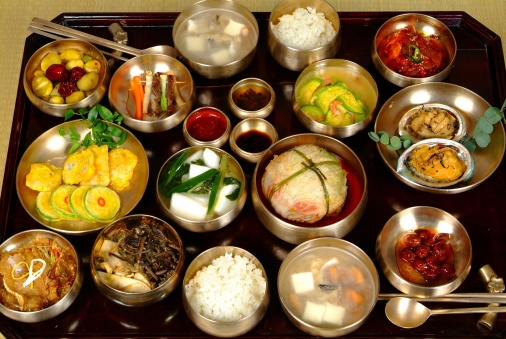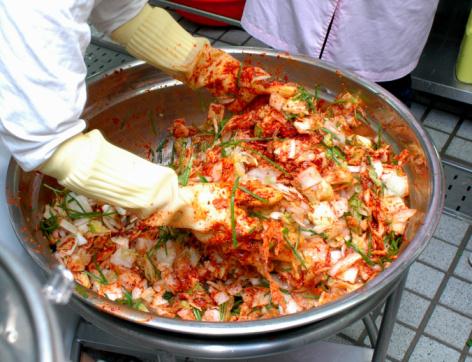Here's how Filipinos have grown to love Korean food

All around Metro Manila, Korean restaurants and Korean grocery stores have been popping up one after another. And judging by the long lines outside them — formed not so much by Korean residents as Filipino nationals, it would be safe to say Korean food has drawn Filipinos as much as K-drama, K-pop and K-beauty.
What draws us Filipinos to Korean cuisine? Anthropologist and historian, Arnel Joven explains this attraction to Korean cuisine as a product of people’s fondness for K-dramas and K-pop.
“Korean cuisine is attractive to many Filipinos in terms of its phenomenology in popular and social media," Joven began. "Salient promotion of Korean cuisine is embedded in many Korean dramas, regardless of genre. At the same time, K-pop fandom also magnifies this phenomenology of Hansik (Korean cuisine) popularity within the past two decades in the Philippines,” says Joven.
Joven’s observation is supported by the fact that Netflix’s Top 10 in the Philippines as of April 1, 2020 includes five (5) K-dramas with "Crash Landing on You" and "Itaewon Class" topping the list.
If you watch K-dramas, you will observe that Korean food is prominently showcased as it takes center stage along with the kilig factor, enticing viewers to try the dishes for themselves after each series’ concluding episode.
Me today because calories don’t exist on the weekends: ????????????????????
A post shared by Netflix Philippines (@netflixph) on
For how can one resist the temptation of slurping ramyeon just like the romantic couples in "Crash Landing On You"? Or biting into that tasty meat straight from the grill (samgyupsal) as seen in "What’s Wrong with Secretary Kim"? Or feasting on rice cakes (tteokbokki) while gossiping with girlfriends and breaking goldfish bread with the boys just like in "Reply 1988"? Or downing shot glasses of soju paired with Korean fried chicken on a Friday night out on the town with the gang like in "Goblin"? The list goes on.
Fun fact: ramyeon’s export volume grew by 27.5 percent in only one year during the pandemic. Another: Jjapaguri, a mix of jjapaghetti (sweet blackbean noodles) and neoguri (seafood udon noodles) as seen in the award-winning movie "Parasite" became such a bestseller that noodle maker Nongshim created a new brand of the noodles.
The ‘hallyu wave’ or the worldwide spread of South Korean culture actually began in the late 1990’s. When it reached our shores in the early 2000s via K-dramas, Filipinos embraced it with much enthusiasm.
A 2018 research among 113 countries by the Korea Foundation determined that the Philippines had the highest growth rate of hallyu fans. In addition, a 2011 study by TNS Global entitled “Filipino Perception of Korea and the Koreans” revealed that Korean culture is one of the top three cultures Filipinos are fascinated by, along with American and Japanese.
With these findings, it is not surprising that South Korea has the highest positive image in the Philippines, based on the Korean Culture and Information Service’s survey in 2020.
Sharing the credit for the growing love for Korean cuisine is Korean popular music or K-pop. Unless you have been living under a rock, young and not-so-young people alike absolutely worship their ‘biases’ from Seventeen, BTS, Blackpink, and other K-pop groups.
Korean culinary delights in the Philippines have a historical background, too. Joven’s research, “Hansik and Hallyu: An Analysis of the Filipino Appropriation of Korean Cuisine as a Function of Imagining Korean Culture” laid out the phases of Korean cuisine (hansik) in our country.
“Prior to the early 2000s, Korean culture was practically unheard of in the Philippines, apart from ‘Korean War’ and ‘North Korea’ - which were practically the only things that the western world knew about Korea back then,” Joven says. This changed when Koreans started coming to the Philippines for extended stays either for work or for education.
The first wave is hansik for Koreans, where Koreans informally exposed Filipinos to their food, particularly kimchi, as they entered and resided in the Philippines. Korean restaurants initially opened in the Philippines to attract expats.
Hansik for Filipinos is the second wave, with Korean restaurants piquing the curiosity of Filipinos. The spiciness of Korean food led Filipinos to either try to tone down the taste or take in its authenticity, if they could actually take it. Remember the trending “spicy ramen challenge” a few years ago?
Matutukoy na ang karamadaman ng Inang Reyna. Gagawa ng tableta si Jang Geum upang mapagaling ang Inang Reyna ngunit...
Posted by GMA Jewel In The Palace on Wednesday, 23 July 2014
Third is the "Jewel in the Palace effect." In 2003, the Korean period drama "Jewel in the Palace" aired in the Philippines, which had viewers glued on the character, Janggeum’s, cooking and traditional table setting. While show branded Korean food as healthy, gaining interest from a multitude of health-conscious Filipinos, other food-inspired TV shows like "Baker King Kim Tak-gu," "Let’s eat," "Gourmet," and "Pasta" followed and showed different facets of Korean food.
Last but not the least is the professionalization or replication of this cuisine by Filipinos, brought about by Koreans’ need to hire local labor, Filipinos’ desire to set up their own Korean food businesses, the evolution of Korean fast food outlets, and practicality for future overseas Filipino workers in Korea.
Filipinos’ exposure to Korean cuisine heightened further when a great deal of Korean boys and girls flocked to the Philippines to study English. This resulted in ajummas or Korean middle-aged women, who accompanied their children or wards, setting up small-scale Korean eateries and barbeque places.
The story behind the first Korean restaurant in the Philippines is quite interesting. When some members of the Joseon Dynasty immigrated to the country in the early 20th century, they sold ‘GoryeoInsam’ (Goryeo Dynasty ginseng) mainly in Binondo, the hub for oriental pharmacies then.
In the 1960s, ginseng merchant Sang-bok Cho opened the very first Korean restaurant in Manila called “Korean House”, which marketed to Korean migrants. Other Koreans (some with Filipino business partners) followed suit so that from 2014 to 2018, the number of Korean restaurants in the Philippines increased by an astounding 81.2%, according to the Korean Food Promotion Institute.

Culturally, Filipino culture produces an inclination towards Korean cuisine. Joven’s study revealed that the following are the most popular dishes among the Filipino respondents surveyed, who found similarities between Korean and Filipino dishes: kimchi as the “number one side dish,” bulgogi as barbecue or grilled meat, bibimbap as a scrumptious rice bowl, japchae as the Korean counterpart of bihon or sotanghon, and kimbab as a sushi-looking dish.
“There is the element of locating for familiarity in common or local dishes. Korean cuisine serves as a sort of third-party alternative between traditional Filipino cuisine and western food,” Joven concludes.
While noted Filipino chef Sharwin Tee agrees that the proliferation of Korean pop culture in the Philippines (and in the world) has contributed to Filipinos’ attraction to Korean cuisine, he says that such is not enough. Some food may appear in K-dramas, but do not attract the Filipino palate.
“K-dramas have definitely been the main proponent of Korean cuisine's popularity, but it wouldn't have this staying power if the flavors didn't somehow resonate with the Filipinos," Tee said.
"If one takes a closer look, the fascination with Korean cuisine only covers food and flavors that are friendly and familiar. Samgyupsal (especially ‘unli samgyup’), galbi, bulgogi, kimchi fried rice are all familiar and friendly to Filipino palates. That's why they stayed popular,” Tee adds.
Samgyupsal is often viewed as authentic Korean dining, with its usage of chopsticks, dipping grilled meat in ssamjang (spicy soybean paste), and wrapping it in lettuce.
Filipinos and Koreans alike see the striking resemblance between samgyupsal and liempo. He also cites the usage of pork to flavor dishes and fermented ingredients as some similarities between Korean and Filipino cuisine.
A study conducted by the Korea Trade-Investment Promotion Agency (KOTRA) Manila revealed that Filipinos are voracious pork-eaters, consuming 28.89 kg of meat per individual with pork comprising 49 percent thereof. This figure is 1.8 kg. more than the international average! No wonder we Filipinos are avid fans of eat-all-you-can samgyupsal.
Tee mentions some less popular Korean dishes that do not agree much with Filipinos such as soy marinated crabs, gukbap, samgyetang, kalguksu, and jajangmyeon. A number of banchan or side dishes like water kimchi and seasoned perilla leaves do not appeal to us as much either. Filipinos’ focus on viands over side dishes could be an explanation for this.
Given all these reasons, the long lines of Filipinos outside Korean grocery stores in our neighborhood is not such a surprising phenomenon, after all. Saranghae, bibimbap, pajeon, ramyeon, japchae, kimchi, kimbap, bulgogi jeongol, and so it goes! — LA, GMA News




